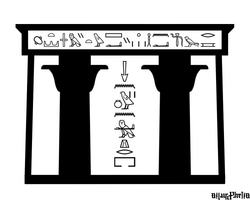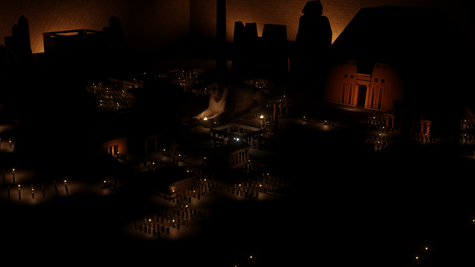| Warehouse 2 | |
|---|---|

| |
| An oasis between sand and sea | |
|
Location |
Egypt |
|
Host Nation Government |
Ptolemaic Dynasty |
|
City or Town |
Alexandria |
|
Years Active |
323 BC - 30BC |
|
Status |
Deactivated |
|
Caretaker(s) |
Pef-nifi-neith |
|
Reason for Relocation |
Rise of the Roman Empire |
|
Previous Warehouse |
|
|
Subsequent Warehouse |
|
| [Source] | |
Warehouse 2 was the 2nd incarnation of the Warehouse which was housed by the Ptolemaic Dynasty in Alexandria, Egypt.
It was inducted by Ptolemy I Soter I around 323 B.C. and was finished sometime around 20 years later in 303 B.C.
Warehouse 2 officially came to an end sometime after the death of the Pharaoh Cleopatra on August 30 B.C. Unable to safely evacuate the majority of the artifacts, the regents of Warehouse 2 buried and sealed what remained, and the structure and its secrets were presumably lost to time.
It wasn't until 2010 that agents of Warehouse 13 recovered the lost warehouse, as well as the artifacts inside. (SEE WAREHOUSE 13 FILES)
Two Caretakers were employed for Warehouse 2:
- Pef-nifi-neith
- Henuttawy
Location & Building[]
This Warehouse was built in Alexandria, Egypt, as per previous caretaker Alexander the Great's instructions, but not in it's original destination. Alexander had intended for the Warehouse to built in Alexandria proper, placing his satrap Cleomenes in charge of it's construction. But Ptolemy, afraid that Cleomenes had revealed the secrets of the Warehouse to Perdiccas (SEE WAREHOUSE 1 FILES), changed the plans last minute to nearby hill Alam Nafaza, under the guise of the construction of his tomb.
The original site of Warehouse 2 was then used for Ptolemy's Library of Alexandria.
List of main contributors to the building of Warehouse 2:
- Ptolemy I Soter I: Original general for Alexander The Great whom became leader of Egypt during the Ptolemaic dynasty and oversaw the moving of Warehouse 1 to 2.
- Euclid: Provided great technological advancements to the building of Warehouse 2, including one of the three tests, "The Mind Test".
- Parmenion: Main architect that Alexander the Great chose to build his personal vault, also oversaw the building of Warehouse 2.
History[]

The general floor layout of Warehouse 2
The beginning of a golden age, Warehouse 2 flourished under the Ptolemic Rulers, acquiring many Egyptian artifacts, including the skin from the asp that killed Cleopatra. It was under these first rulers that the Warehouse established its own system of rule and control, and a group of people from all walks of life was appointed to oversee it - The Regents. The Regents were the first actual "agents" of the Warehouse, and its first collectors of artifacts. Its residence in Egypt lasted until the suicide of Cleopatra, and the conquest of Egypt by Caesar and Rome.
Sections[]
Similar to it's previous iteration, this Warehouse did not at first categorize artifacts in large sections like later Warehouses would. However, Warehouse 2 was the first to implement artifact neutralizer, and thus begin a rudimentary sorting of more dangerous artifacts that would lead to both the first Armory and the first Dark Vault.
Notable Artifacts[]
- Menander's Comedy Masks: Has the power to induce situational comedic events that lead to catastrophic (and ironic) series of events. Always leads to the death of someone.
- Amenhotep III's Miniature Obelisk: Able to erect immense monuments when placed around building materials, removing the keystone on top of the miniature obelisk will cancel the effects.
- Aristippus of Cyrene's Goblet and Grape Bowl: Holding the goblet and bowl will give the holder a instant hangover. When only the goblet is held, the holder may experience immense bouts of hedonistic pleasure, while the holder of the grape bowl may instantly become more conservative and level headed, at the cost of being obnoxious and prudish.
- Ramesses I's Headdress: Grants popular appeal, authoritative power and extended lifespans to descendants. Drains the wearer’s own willpower and self-importance.
Notable Regents[]
- Besa
- Bakari
- Aut
- Her-ben
- Onouris
- Khaen-suas
- Anoubapion
- Het-het
- Khufu-mer-nuter-u (Defined as the "Custodian" of Warehouse 2)
Enemies/Adversaries[]
- Pa-du-pthah
- Baniti
- Babi
- Har-em-ha
- Har-m-ankh-amen
- Ra-ua-hab
- Het-aai
- Yahya
- Khair
- Nkrumah
- Julius Caesar
Affiliates[]
- Cleopatra VII Philopator
- Marc Anthony
- Marcus Brutis
Events[]
DUE TO RECENT EVENTS LOST WAREHOUSE 2 FILES HAVE NOW BEEN RECOVERED[]
February 150 B.C.E.[]
- 5th: The conflict with the Olympians, which will become known as the Deiomachy, begins.
March 32 B.C.E.[]
- 3rd: The Regents suspect the Warehouse must eventually be moved, in accordance to the increased Roman influence over the Ptolemaic dynasty in the past century. They confirm the new location of Warehouse is to be in Rome, Italy. Three Regents are sent to the city to determine where they should build the secret complex.
August 30 B.C.E.[]
- 1st-12th: Antony and Cleopatra commit suicide.
October 30 B.C.E.[]
- 18th: The three Regents based in Rome receive the only surviving Regent of the presumed destruction of Warehouse 2, and only a small collection of the artifacts. She is unable to explain what happened before she dies of a possibly artifact-related sickness.
- 19th: Warehouse 3 officially opens.
September 2010 C.E.[]
- 14th: The remaining entry way to Warehouse 2 is uncovered by three students under the pay of Agent Helena Wells in a plot to find the staff of the Minoan Trident. The students succumb to a hematite and natron compound trap on the surface hours later, but the damage is done - Warehouse 2 is back online, and begins claiming current Caretaker of Warehouse 13, Irene Frederic, as it's own.
- 15th: Warehouse 2 is explored by Regent Benedict Valda and Agents Myka Bering, Pete Lattimer, and Helena Wells. Valda is killed at the second trap. Bering and Lattimer successfully deactivate the Warehouse, activating the original self-burying mechanism. Wells flees the Warehouse with half of the Minoan Trident.
- 21st: Work begins on unearthing Warehouse 2 and reclaiming it's artifacts.
May 2011 C.E.[]
- 4th: Warehouse 2 is completely excavated, and permanently buried.
Technology[]
Though Alexander created the first collection of artifacts, it was during it's time in Egypt that the Warehouse was truly formed. The move of control of the Warehouse from Alexander the Great to Ptolemy I, and eventually to the regents, was a messy process; it necessitated defining power structures, securities, and protocols that had not been formed under Alexander's reign. Though basic in design, nearly all facets of Warehouse structure can be traced back to the trials and errors that Warehouse 2 experienced.
Warehouse 2 was the first Warehouse to discover neutralizer fluid, which originated as a tincture of panite, gold, Nile water, water buffalo urine, and the vomit of the giant purple swamphen.
Though the site of the Library of Alexandria was never officially a Warehouse as Alexander and Cleomenes had expected, it was utilized as the first Regent Vault. Due to the library's close proximity to the Lighthouse of Alexandria, regents traveling into the city by sea were instructed to take their findings to the library until they could be safely smuggled out of the city and into the Warehouse proper. Some artifacts, it seems, were kept at the library for various reasons of safety, and may have been lost when Julius Caesar razed the library in a misguided attempt to find the Warehouse.
Reasoning For Shift[]
Rise of the Roman Empire[]
The Warehouse moved to its next location shortly after Cleopatra's death. However, the Warehouse was not properly deactivated, due to the invasion of the Romans in 31 B.C.

Gallery[]
| Warehouses |
|---|
| Warehouse 1 • Warehouse 2 • Warehouse 3 (Mayan Branch) • Warehouse 4 • Warehouse 5 • Warehouse 6 • Warehouse 7 • Warehouse 8 • Warehouse 9 • Warehouse 10 • Warehouse 11 • Warehouse 12 • Warehouse 13 |















